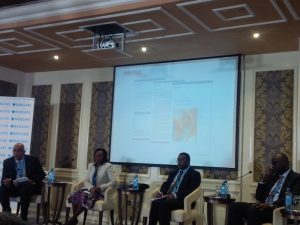Today Barclays Africa economists gave their forecasts on Africa and specifically Kenya for the year 2017 at an event that featured several roundtables sessions.
- Populism: During 2016 the world changed in terms of two surprising votes in the US and the UK that reflected an inward focus. The votes in those countries were driven by populations who felt that their politicians were not pushing their agendas on matters such as trade and immigration. Also while incomes of the rich & poor have been improving, those of the middle class have stayed stable or declined.
- US President-elect Trump is expected to reduce the US corporate tax rate which may woo companies to bring back some of the $2 trillion profits sitting outside the US.
 Banks are seen as making too much money and not playing their part in society – this has resulted in things like the interest rate cap law in Kenya.
Banks are seen as making too much money and not playing their part in society – this has resulted in things like the interest rate cap law in Kenya.- Reaching Entrepreneurs: There are 40-50 million emerging SME’s in Africa but only 1/5 of them have access to capital, and this is because banks ask for collateral
- Banks operate in cash driven economies and many entrepreneurs don’t want to share information. Banks also have to collect a lot of documentation that bothers customers.
- Barclays is committed to making sure there’s no systemic risk from their exit from Africa, and that its customers will continue to get good service in all the 10 markets
- Barclays has a platform called Rise with centers in London, New York, Cape Town, Mumbai, Tel Aviv where they partner with companies on ideas to be implemented.
- Africa: The continent is now becoming a bit more fragile, and for the first time in a decade, Africa is going to grow at a slower pace than the global average 3.5% (but if you exclude South Africa and Nigeria), the growth is still above average for most
- African countries have been spending much more than their revenue and the years of deficits have eroded Africas strong starting point. Going forward, African countries will face higher financing cost and lower capital inflows.
- Brexit Impact: 45% of FDI into Africa comes from Europe and Kenya gets 23% from the UK. But the pound has continued to weaken since the vote and this will result in reduced global demand for African exports, less tourism from UK/EU, and reduced remittances from African migrants
- Kenya: The shilling currency has been weakening at a lower rate than its peers. This could make exports expensive and widens the current account deficit. It’s possible that the Kenya shilling could depreciate to 110/$ over the next 12 months. This is mainly due to the expected dollar strength against all currencies. Kenya has strong exchange reserves and can tap an IMF precautionary fund to cushion shocks.
- East Africa: Trade lags the rest of the world. Since East African borders “opened up” around 2010, Kenya’s exports to the EAC have only increased by 8% compared to 50% to the rest of the world.

great updates on economic affairs.